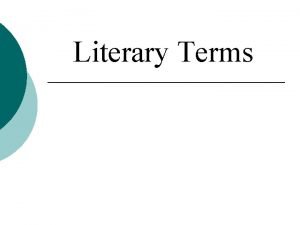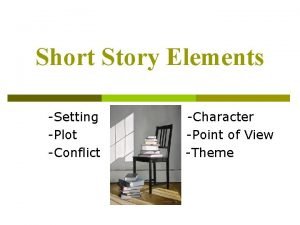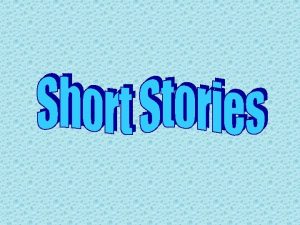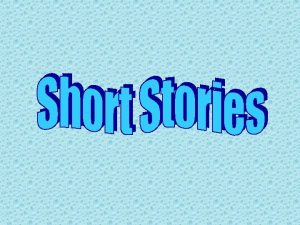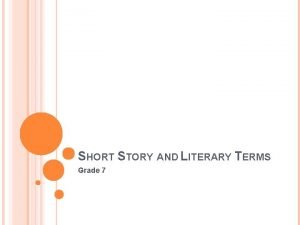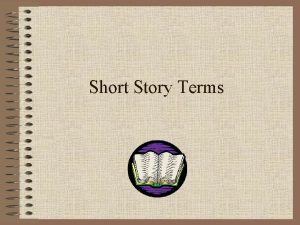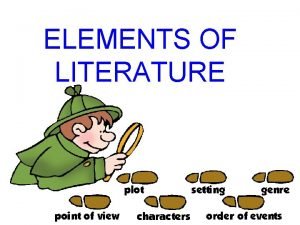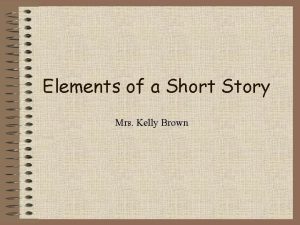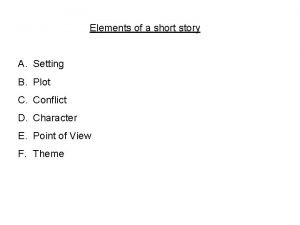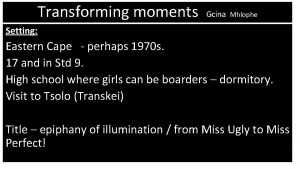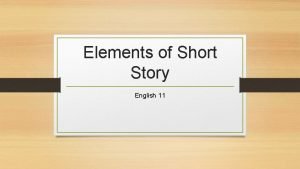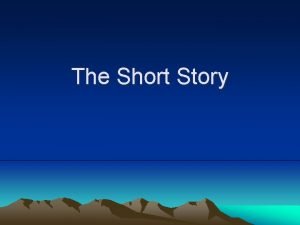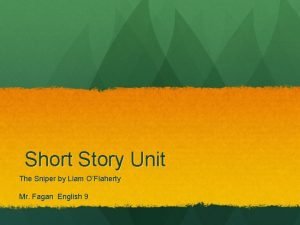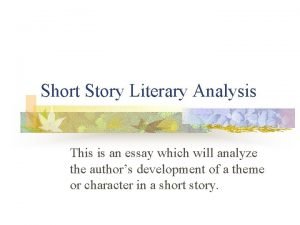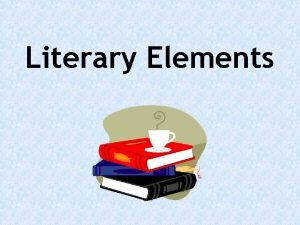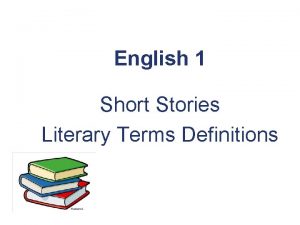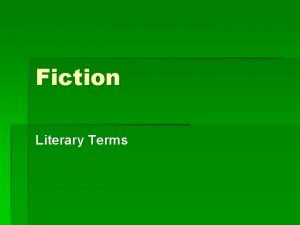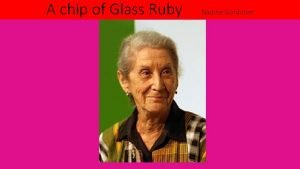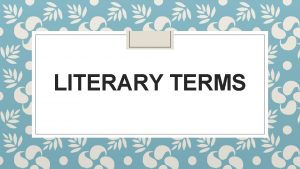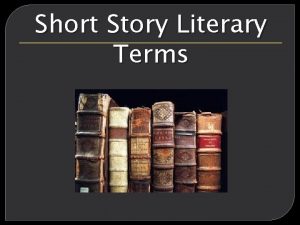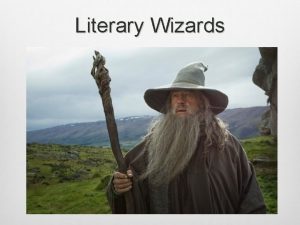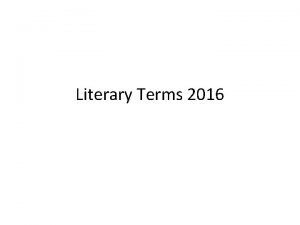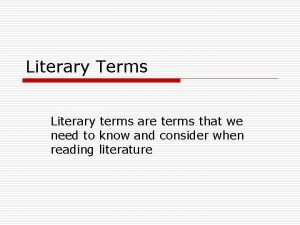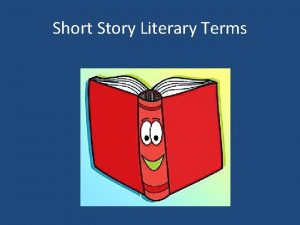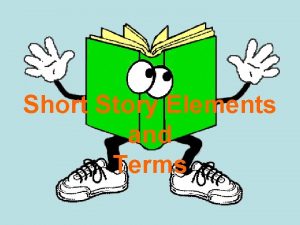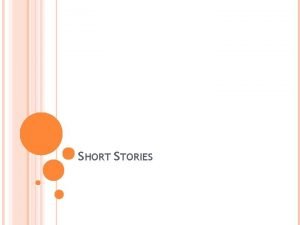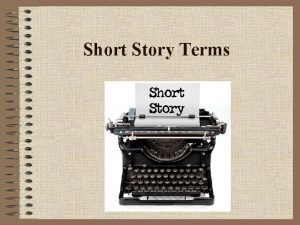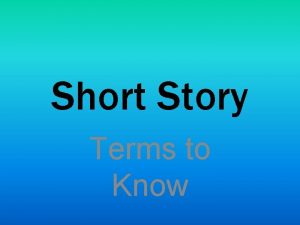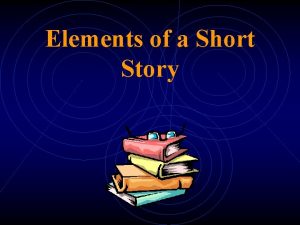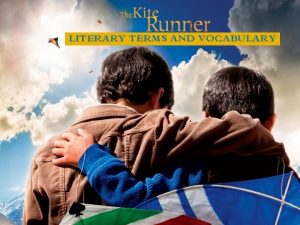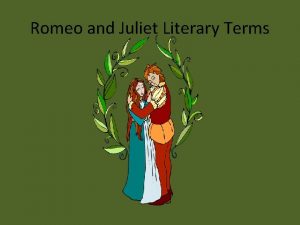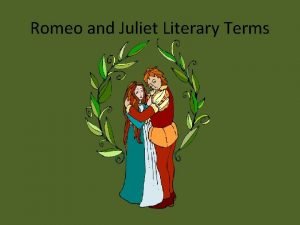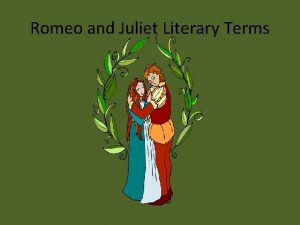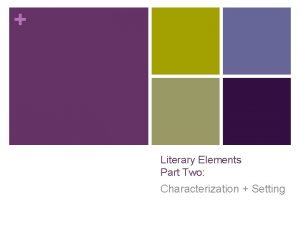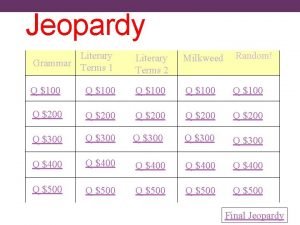SHORT STORY AND LITERARY TERMS Grade 7 SETTING























- Slides: 23

SHORT STORY AND LITERARY TERMS Grade 7

SETTING The time and place that a story occurs in. Place – geographical location – can be a country, state, or town, but can also be a store, a park, etc. Time – When is the story taking place? (historical period, time of day, year, month, etc. )

PARTS OF A PLOT Plot – the sequence of events, or action, in a story. Exposition – this is where the reader learns the background information necessary to understand the story (introduces setting, main characters, and what is going on. ) � Example: Liz is 25, lives in an apartment by herself, and is a nurse. She is talking on her phone to her friend Julie as she walks to the door of her home.

Rising Action – part of the story between the exposition and the climax. This is where most of the events in the story happen, where the conflicts occur and build up the story. � Example: Liz hears strange thumping from her apartment and tells Julie suggests Liz call the police. Liz tells Julie she was probably imagining the sounds.

Climax – the turning point or highest point of action in a story. At the climax the main character realizes what has to be done to fix the major conflict. � Example: Liz opens the door to her apartment and sees a pair of black shoes peeking out from under the curtain. The curtain moves slightly. Liz picks up a candlestick and swings at the curtain when a hand reaches out and grabs her. A masked man steps out from behind the curtain.

Falling Action – the part of the story after the climax and before the resolution. Here is where loose ends are tied up and we learn the extra information. � Example: The man tries to run from her house, but is met by the police. Julie had called the police for Liz realizes some of her possessions are knocked over and broken.

Resolution – the final outcome or ending to the story. � Example: Liz packs a bag to go stay at Julie’s for the night. Liz also decides to install an alarm system.

FREYTAG’S TRIANGLE Climax Rising Action Exposition Falling Action Resolution

CONFLICT A problem a character deals with in the novel Internal – a conflict that occurs in a character’s mind � Person vs. self External – a conflict that occurs between a character and an outside force � Person vs. person � Person vs. nature � Person vs. society � Person vs. fate

MAJOR CHARACTERS The most important characters in a story. The story revolves around the lives of these couple characters.

MINOR CHARACTERS The less important characters in the story. They interact with the major characters, but the plot is not centered on them.

CHARACTER TRAITS The characteristics of a character that are shown through the narration and dialogue. � Brave/courageous � Outgoing � Adventurous � Mean � Stubborn � Rude � Loyal � Intelligent

NARRATOR Character who tells the story to the audience He or she can be a character in the story, or an outsider looking in.

POINT OF VIEW Point of view – who is telling the story � 1 st Person – the narrator is a character in the story and tells it from his/her point of view. Uses “I” or “me” when telling the story. � 3 rd Person – the unbiased narrator tells the story as an observer and uses “he, ” “she, ” and “they” to tell the story � 3 rd Person Omniscient – the narrator can see thoughts and feelings of multiple characters and shares them with the reader – still uses “he, ” “she, ” and “they. ”

FORESHADOWING The use of hints or clues to indicate events and situations that will occur later in the plot � Spooky music � Thunder and lightning � A new suspicious character introduced where their purpose is unknown

SUSPENSE The excitement or tension a reader feels when reading. �I wonder what will happen next?

THEME A message or moral about life that a writer is trying to get across to the reader. �A theme is a complete sentence and must apply to the story as well as to life in general � A good way to find theme is to ask yourself “What does the main character learn? ” Examples: Sometimes we must sacrifice something valuable to save someone we love. Money does not guarantee happiness. Love is the worthiest of pursuits.

MOOD The emotions that you feel when you are reading – may make you feel sad, joyful, or angry. (normally a story has ONE mood) Created by the author’s words and images Types of mood: scary, romantic, violent, hopeful, mysterious, joyful…

DESCRIBE THE MOOD

DESCRIBE THE MOOD

DESCRIBE THE MOOD

DESCRIBE THE MOOD

DESCRIBE THE MOOD
 Tall+short h
Tall+short h Short story in literary terms
Short story in literary terms Introduction of short story
Introduction of short story Story with setting characters and plot
Story with setting characters and plot Short story with characters setting and plot
Short story with characters setting and plot Short story with characters, setting, and plot
Short story with characters, setting, and plot Elements of a short story grade 7
Elements of a short story grade 7 Types of antagonists
Types of antagonists Different elements of literature
Different elements of literature Five story elements
Five story elements Setting of the story
Setting of the story Is gcina mhlophe married
Is gcina mhlophe married Ginny's character in the new tribe
Ginny's character in the new tribe What is the elements of short story
What is the elements of short story The outsiders plot diagram
The outsiders plot diagram Liam o'flaherty
Liam o'flaherty Literary analysis example for a short story
Literary analysis example for a short story Cinderella internal conflict
Cinderella internal conflict Short story literary definition
Short story literary definition Climax the lottery
Climax the lottery A brief work of fiction is also called a
A brief work of fiction is also called a What value does paddy maguire see in a fur coat
What value does paddy maguire see in a fur coat A chip of glass ruby summary grade 12
A chip of glass ruby summary grade 12 Short stories for grade 10
Short stories for grade 10

